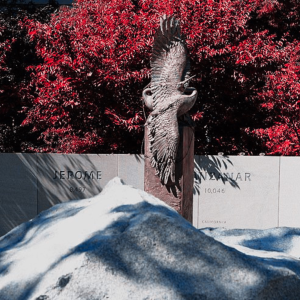Case Studies
To date, we have identified more than five hundred cases on five continents. Our Case Studies relate to a wide array of historical legacies, including colonialism, enslavement, racism, fascism, sectarianism, anti-semitism, communism, authoritarianism, sexual violence and others. To address these often contested legacies, decision-makers and other parties have chosen various remedies. This can take the form of complete removal of the monument, artistic intervention to alter the statue or increased signage for contextualisation.
Case Studies focus on the historical background, history of the contestation, the decision-making process and the remedy employed. Once our Researchers complete them, the Case Studies are internally reviewed by the Contested Histories Team before being sent out for external expert review by our Academic Committee before publication. They are revised when new developments relating to the case to give the most accurate and up-to-date overview possible.


#181
Harvard’s Legacy of Slavery in Cambridge, Massachusetts
USA
In the past decade, Harvard University has taken great strides to acknowledge the legacy of slavery on campus. Slavery provided an impetus for the creation of resources at Harvard, and several enslave… Read More
Harvard’s Legacy of Slavery in Cambridge, Massachusetts
In the past decade, Harvard University has taken great strides to acknowledge the legacy of slavery on campus. Slavery provided an impetus for the creation of resources at Harvard, and several enslave… Read More
In the past decade, Harvard University has taken great strides to acknowledge the legacy of slavery on campus. Slavery provided an impetus for the creation of resources at Harvard, and several enslaved Black and Indigenous individuals of former university presidents even resided… Read More


#198
Stone Mountain Park Memorial in Georgia
USA
The Stone Mountain Park Memorial is the largest Confederate memorial in the U.S., and the controversy around it demonstrates that the American Civil War’s emancipatory purpose remains contested more t… Read More
Stone Mountain Park Memorial in Georgia
The Stone Mountain Park Memorial is the largest Confederate memorial in the U.S., and the controversy around it demonstrates that the American Civil War’s emancipatory purpose remains contested more t… Read More
The Stone Mountain Park Memorial is the largest Confederate memorial in the U.S., and the controversy around it demonstrates that the American Civil War’s emancipatory purpose remains contested more than a century-and-a-half after its end. Despite multiple protests, and a guberna… Read More


#63
Stumbling Stones in Munich
Germany
Stolpersteine or ‘stumbling stones’ are components of a project initiated by German artist Gunter Demnig in 1996 to commemorate victims of the Holocaust. The memorials, in the form of cobblestones ins… Read More
Stumbling Stones in Munich
Stolpersteine or ‘stumbling stones’ are components of a project initiated by German artist Gunter Demnig in 1996 to commemorate victims of the Holocaust. The memorials, in the form of cobblestones ins… Read More
Stolpersteine or ‘stumbling stones’ are components of a project initiated by German artist Gunter Demnig in 1996 to commemorate victims of the Holocaust. The memorials, in the form of cobblestones installed in public streets, now number in the tens of thousands across Europe and… Read More


#282
Khala Goda Statue in Mumbai
India
The Kala Ghoda (Black Horse) statue is a 16.7-foot-tall bronze statue in Mumbai, India, and a prominent relic of the country’s colonial era. The equestrian statue of King Edward VII became contentious… Read More
Khala Goda Statue in Mumbai
The Kala Ghoda (Black Horse) statue is a 16.7-foot-tall bronze statue in Mumbai, India, and a prominent relic of the country’s colonial era. The equestrian statue of King Edward VII became contentious… Read More
The Kala Ghoda (Black Horse) statue is a 16.7-foot-tall bronze statue in Mumbai, India, and a prominent relic of the country’s colonial era. The equestrian statue of King Edward VII became contentious during a period of rising nationalistic sentiments opposing symbols of imperial… Read More


#121
Shaheed Bhagat Singh Roundabout in Lahore
Pakistan
Commonly known as Fawara Chowk (Fountain Roundabout), the formal name, Shaheed Bhagat Singh Chowk roundabout, has been the source of contestation since 2016. The roundabout is directly adjacent to the… Read More
Shaheed Bhagat Singh Roundabout in Lahore
Commonly known as Fawara Chowk (Fountain Roundabout), the formal name, Shaheed Bhagat Singh Chowk roundabout, has been the source of contestation since 2016. The roundabout is directly adjacent to the… Read More
Commonly known as Fawara Chowk (Fountain Roundabout), the formal name, Shaheed Bhagat Singh Chowk roundabout, has been the source of contestation since 2016. The roundabout is directly adjacent to the former prison where Sikh Marxist-Revolutionary Bhagat Singh was executed in 193… Read More


#236
Mullivaikkal Memorial at Jaffna University
Sri Lanka
On the night of January 9, 2021, students protested outside of Jaffna University against the university’s decision to destroy a memorial commemorating the Tamil victims of the three-decade-long civil… Read More
Mullivaikkal Memorial at Jaffna University
On the night of January 9, 2021, students protested outside of Jaffna University against the university’s decision to destroy a memorial commemorating the Tamil victims of the three-decade-long civil… Read More
On the night of January 9, 2021, students protested outside of Jaffna University against the university’s decision to destroy a memorial commemorating the Tamil victims of the three-decade-long civil war. The war ended in 2009 at Mullivaikkal, a small village in the northeast coa… Read More


#184
WWII Japanese American Memorial in Washington DC
USA
The Japanese American Memorial to Patriotism During World War II in Washington, D.C., United States, is a monument to the 112,581 Japanese Americans incarcerated by the U.S. Government during World Wa… Read More
WWII Japanese American Memorial in Washington DC
The Japanese American Memorial to Patriotism During World War II in Washington, D.C., United States, is a monument to the 112,581 Japanese Americans incarcerated by the U.S. Government during World Wa… Read More
The Japanese American Memorial to Patriotism During World War II in Washington, D.C., United States, is a monument to the 112,581 Japanese Americans incarcerated by the U.S. Government during World War II. It also commemorates Japanese Americans who served in the U.S. Military. T… Read More


#112
Mussert’s Wall in Lunteren
Netherlands
In 1936, the Dutch fascist party NSB constructed a complex in the town of Lunteren called Mussert’s Wall (Muur van Mussert), where they would hold political rallies. After being neglected for decades… Read More
Mussert’s Wall in Lunteren
In 1936, the Dutch fascist party NSB constructed a complex in the town of Lunteren called Mussert’s Wall (Muur van Mussert), where they would hold political rallies. After being neglected for decades… Read More
In 1936, the Dutch fascist party NSB constructed a complex in the town of Lunteren called Mussert’s Wall (Muur van Mussert), where they would hold political rallies. After being neglected for decades after World War II, in 2015, a national discussion arose following requests by l… Read More


#130
Old Slave Market in Lagos
Portugal
Hiding in plain sight in Lagos’ central square lies the Antigo Mercado de Escravos, the Old Slave Market, which hosts a unique museum. The building is situated in the square–formerly a beach–where ens… Read More
Old Slave Market in Lagos
Hiding in plain sight in Lagos’ central square lies the Antigo Mercado de Escravos, the Old Slave Market, which hosts a unique museum. The building is situated in the square–formerly a beach–where ens… Read More
Hiding in plain sight in Lagos’ central square lies the Antigo Mercado de Escravos, the Old Slave Market, which hosts a unique museum. The building is situated in the square–formerly a beach–where enslaved people would once have been bought and sold, along with other goods such a… Read More


#139
Van Riebeeck’s Hedge in Cape Town
South Africa
Jan van Riebeeck arrived at Cape of Good Hope in 1652. His mission was to create a station for the Dutch East India Company’s ships. This meant colonising the lands inhabited by the Khoikhoi. To keep… Read More
Van Riebeeck’s Hedge in Cape Town
Jan van Riebeeck arrived at Cape of Good Hope in 1652. His mission was to create a station for the Dutch East India Company’s ships. This meant colonising the lands inhabited by the Khoikhoi. To keep… Read More
Jan van Riebeeck arrived at Cape of Good Hope in 1652. His mission was to create a station for the Dutch East India Company’s ships. This meant colonising the lands inhabited by the Khoikhoi. To keep them from accessing his land, van Riebeeck planted a wild almond hedge. The hedg… Read More


#281
José Miguel Gómez Statue in La Habana
Cuba
José Miguel Gómez was a celebrated military general who led Cuban forces during the wars of independence against Spain in the 19th century and served as Cuba’s second president between 1909 and 1913. Read More
José Miguel Gómez Statue in La Habana
José Miguel Gómez was a celebrated military general who led Cuban forces during the wars of independence against Spain in the 19th century and served as Cuba’s second president between 1909 and 1913. Read More
José Miguel Gómez was a celebrated military general who led Cuban forces during the wars of independence against Spain in the 19th century and served as Cuba’s second president between 1909 and 1913. The monument was first inaugurated in 1936. The statue has consistently been a s… Read More


#222
Cecil Rhodes Gravesite in Matobo Natural Park
Zimbabwe
In 1902 as requested in his last will and testament, British imperialist Cecil John Rhodes was buried atop a granite hill in Zimbabwe’s world-famous Matobo National Park. Almost 120 years later,… Read More
Cecil Rhodes Gravesite in Matobo Natural Park
In 1902 as requested in his last will and testament, British imperialist Cecil John Rhodes was buried atop a granite hill in Zimbabwe’s world-famous Matobo National Park. Almost 120 years later,… Read More
In 1902 as requested in his last will and testament, British imperialist Cecil John Rhodes was buried atop a granite hill in Zimbabwe’s world-famous Matobo National Park. Almost 120 years later, the site of his grave has become increasingly contested in light of his intimat… Read More
